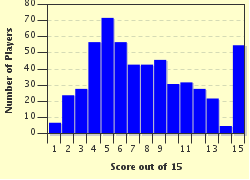Quiz Answer Key and Fun Facts
1. Which of the following is NOT an accepted criterion for a mass extinction event?
2. Which of the following mass extinctions occurred first?
3. Which of the following events resulted in the most species extinctions overall?
4. A comet or asteroid impact on the earth is a frequently suggested cause for many of the mass extinctions. For which of the major mass extinctions does the most evidence exist that this was the main trigger for the event?
5. What is another widely used name for the Cretaceous-Tertiary boundary?
6. In our planet's violent past, flood basalts have been found to have been a possible cause of extinctions. What is a flood basalt?
7. Methane clathrates are another possible factor in global extinction events. What are they?
8. The Ordovician-Silurian event was the second largest known extinction. For many years, it was believed that an ice age brought on by the glaciation of the Gondwana continent was the primary cause of the extinction. Which of the following is a new theory that is gaining support among scientists?
9. Which of the following has the most support among scientists as the cause of the largest extinction event during the Permian era?
10. The Devonian extinction had the most effect on which community of species that were living at the time?
11. The End Triassic extinction which occurred on the Triassic-Jurassic boundary had what "beneficial" effect on the period following this event?
12. Which of the following is true of the Permian Extinction?
13. Of the following, which is the most dominant benefit of mass extinctions?
14. Which species did not become extinct early in the Holocene Extinction Era?
15. What do scientists consider the biggest factor affecting the Holocene Extinctions?
Source: Author
pshelton
This quiz was reviewed by FunTrivia editor
crisw before going online.
Any errors found in FunTrivia content are routinely corrected through our feedback system.

